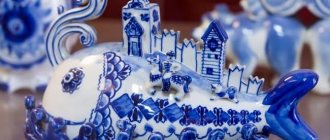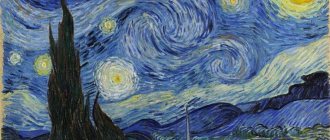Features of Gzhel painting
The uniqueness, grace and incredible beauty of Gzhel products are given by the peculiarities of their painting. These include:
• Snow-white background • Deep blue pattern • Surface glazing • Diverse and complex floral patterns • Handmade
The use of only two colors and the uniqueness of the images make it possible to create unique masterpieces of folk art, therefore, there are no two identical products from Gzhel.
The pattern of the future product is first carefully thought out, and only after that is applied to the porcelain surface. Ancient masters applied the drawing immediately, without a preliminary sketch. They drew their inspiration from nature or from pictures of folk life. Painting is done with a solution of cobalt oxide, which after firing acquires a deep blue color. It is applied with special squirrel brushes.
There is another type of painting in the Gzhel style, which is called majolica. Its peculiarity is that not one color, but five, is applied to the snow-white surface.
Many centuries ago, Gzhel masters tried to reflect in their art their vision of the world around them, pictures of urban and rural life, inexplicable natural phenomena, their thoughts and fantasies. Based on this, the general style of painting can be divided into three main groups:
• Ornamental • Floral • Subject
The ornamental pattern is original, unusual and a certain association can be traced in it. The most common ornamental patterns are: drops, tendrils, blades of grass, pearls, combs. In addition, a checkered pattern is traditionally applied along the side and border, which is a chain of blue squares.
The plant pattern is considered classic for Gzhel. It is usually quite stylized, but you can always distinguish one plant from another. Most often, craftsmen depict berries, blades of grass, cuttings, and flowers on Gzhel products. Garlands of berries on porcelain can easily be intertwined with ears of wheat or a riot of floral patterns. At the same time, gooseberries can be easily distinguished from currants.
Often ornamental painting is combined with a floral pattern.
The plot drawing was one of the first to appear. It presented pictures from the life that surrounded the master. It could be beautiful landscapes, fun fairs, sleigh rides, colorful natural phenomena.
Method of manufacturing Gzhel handicrafts
Creating products for Gzhel requires from the master extraordinary precision, painstakingness and an incredible flight of imagination. The dishes can be made of porcelain or majolica. The difference is that porcelain is white clay. It is more fragile and thin. Majolica is made from red clay and is more durable.
The entire manufacturing process can be divided into five stages. These include:
• Creation of a blank • Preparation for painting and first firing • Control and rejection of products • Painting • Second firing
The preparation process involves creating a porcelain or majolica mold from clay according to the artist’s sketches. This preparation is made on a pottery wheel, but not with your hands, but with special tongs. After the plaster mold is ready, liquid porcelain mass is poured into it, which gradually hardens. Gypsum absorbs moisture well, so porcelain hardens quickly.
An important feature of creating Gzhel is that all elements of the dishes, from handles to relief patterns, are made in different forms. This requires special care and attention from the master.
The next stage is preparation for painting. It includes polishing the product and firing it.
In order for the design to lie smoothly and neatly, each product is first cleaned with a special knife and polished. This process is carried out manually. Then the attachment points of various parts of the product are washed away, and the remaining irregularities are smoothed out using a foam roller. After this, the product is sent to the kiln for firing, which lasts about eight hours.
After firing, it is necessary to monitor the quality of the product and the presence of defects in it. They are identified using a fuchsin solution. This substance accumulates in the uneven surfaces of porcelain and turns bright red. Thus, unevenness or poor-quality joints in the product become visible. Next, imperfections are removed by roller sanding or washing. If the defect cannot be eliminated, the product is sent to scrap and melted down.
After this, painting begins. Each master has his own unique method of applying patterns and signs his work at the end. Then, the supporting parts of the product are treated with paraffin. To do this, the master manually dips the dishes into a bath of hot paraffin. Then, the product is dipped in glaze and sent for a second firing. It lasts quite a long time, eighteen hours. It is thanks to underglaze painting that the color saturation remains the same for a long time. Such products can be washed not only by hand, but also in the dishwasher.
Thus, each stage of the work is performed manually. Such work is very painstaking, therefore, mostly women work in Gzhel factories.
After firing, the product takes on its final form and is subject to subsequent packaging.
Modern masters of Gzhel
Thanks to the creative heritage left by the ancient masters of Gzhel, their modern followers were able not only to revive this great folk craft, but also to introduce into it notes of modern art, features of life and the originality of the views of the present time. At the end of the 19th century, modern Gzhel began to gain popularity, however, they painted mostly simple figures and the design was not as intricate as that of the ancient masters. Gradually, porcelain sculpture and decorative vases began to be mastered, and new original types were added to the traditional Gzhel pattern.
Thus, thanks to modern masters, there was a revival of Gzhel, it acquired new interesting techniques, exciting plots and a special style. Now these products are widely in demand all over the world and are an integral part of Russian folk art.
Gzhel was and remains an unsurpassed symbol of the enormous creative imagination and highest skill of the Russian people. This craft is a kind of history book, which carefully preserves the imprint of the time in which it was created, immerses us in a world full of incredible miracles and unique colors, and tells about how our ancestors lived. However, the popularity of Gzhel lies in the fact that it is capable of displaying pictures of modern times, helping people to look at themselves from the outside, to see how beautiful and amazing the world around them is.
GCD in the senior group “Acquaintance with the history of Gzhel painting. Painting a teapot"
Galina Mutina
GCD in the senior group “Acquaintance with the history of Gzhel painting. Painting a teapot"
Direct educational activities in the senior group.
Topic: “ Introduction to the history of Gzhel painting . Painting a teapot ."
Goal: To develop an aesthetic perception of folk crafts, to teach them to see their beauty; teach children to paint a teapot based on Gzhel painting .
— introduce Gzhel painting in blue tones;
— consolidate the ability to paint with watercolors, learn to paint with the end of a brush;
- teach the technique of blurring colors;
- cultivate interest in folk decorative art; evoke a positive emotional response to beauty.
Materials: presentation “Blue Fairy Tale”
, background music
“Gusli”
, visual material, products of
Gzhel masters , drawing sheets with the image of a teapot and the outline of Gzhel patterns , watercolors, brushes, cups of water, napkins.
Variety of Gzhel shapes
Gzhel products are distinguished not only by a huge variety of designs and original ornaments, but also by a wide selection of shapes.
The world of Gzhel is represented by such objects as:
• Tea pairs • Sets • Flower vases • Teapots • Sugar bowls • Jam sockets • Samovars • Souvenirs
A wonderful and unusual gift in addition to the above are: damask, plaque, kumgan.
Shtof is a tetrahedral-shaped vessel with a short neck and a stopper. In the old days it was used to store strong alcoholic beverages. The plaque, made using the Gzhel technique, is a painted decorative plate and serves as an excellent interior decoration. Kumgan is a vessel with a narrow neck, thin spout, handle and lid. Previously, it was used to wash hands and feet, and now, thanks to the masters of Gzhel, it is a wonderful and memorable gift.
Gzhel is also represented by a rich variety of souvenirs. Among them are figurines of animals, heroes of folk tales, snowmen, fish, nesting dolls, etc. Some of the products are dedicated to representatives of various professions, made in the form of the first leaf of a calendar, or have the shape of a bell.






